16. WORLD WAR – ROUND TWO

PREPARING FOR A POST-WAR WORLD
CONTENTS
 The offensive against the Germans The offensive against the Germans
continues
 Rooseveltian Idealism Rooseveltian Idealism
 The United Nations Organization The United Nations Organization
 Bretton Woods (July 1944) Bretton Woods (July 1944)
 Yalta (February 1945) Yalta (February 1945)
 The Germans in full retreat across The Germans in full retreat across
Germany
The textual material on page below is drawn directly from my work
A Moral History of Western Society © 2024, Volume Two, pages 190-193.
THE
OFFENSIVE AGAINST THE GERMANS RESUMES |
With the halt of the Germans at the
Battle of the Bulge, the offensive against the Germans resumes
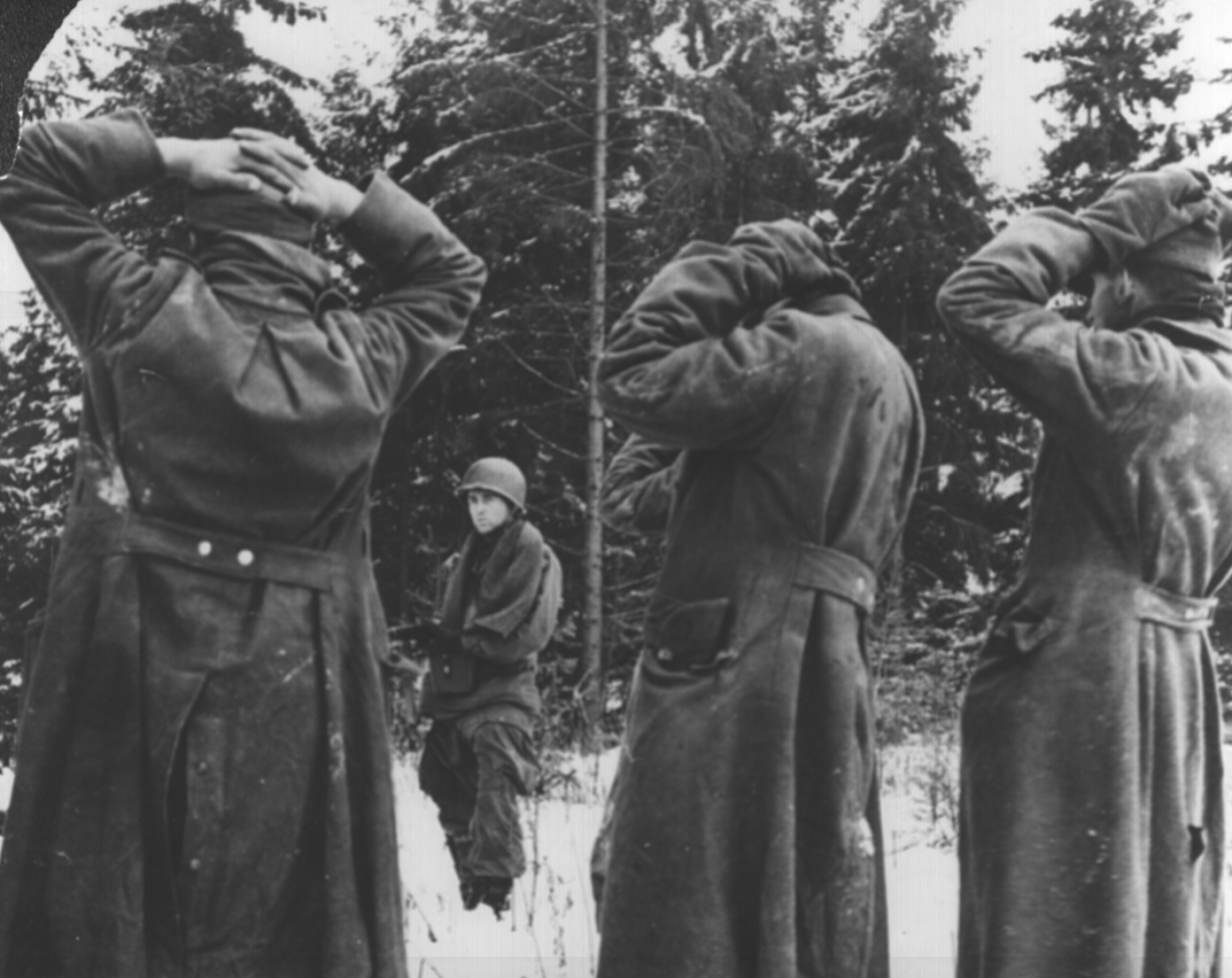 . .
"We were getting our second wind now
and started flattening out that bulge. We took 50,000 prisoners in December
alone." American soldier with captured Germans. Ca. 1944.
National Archives
208-YE-105.
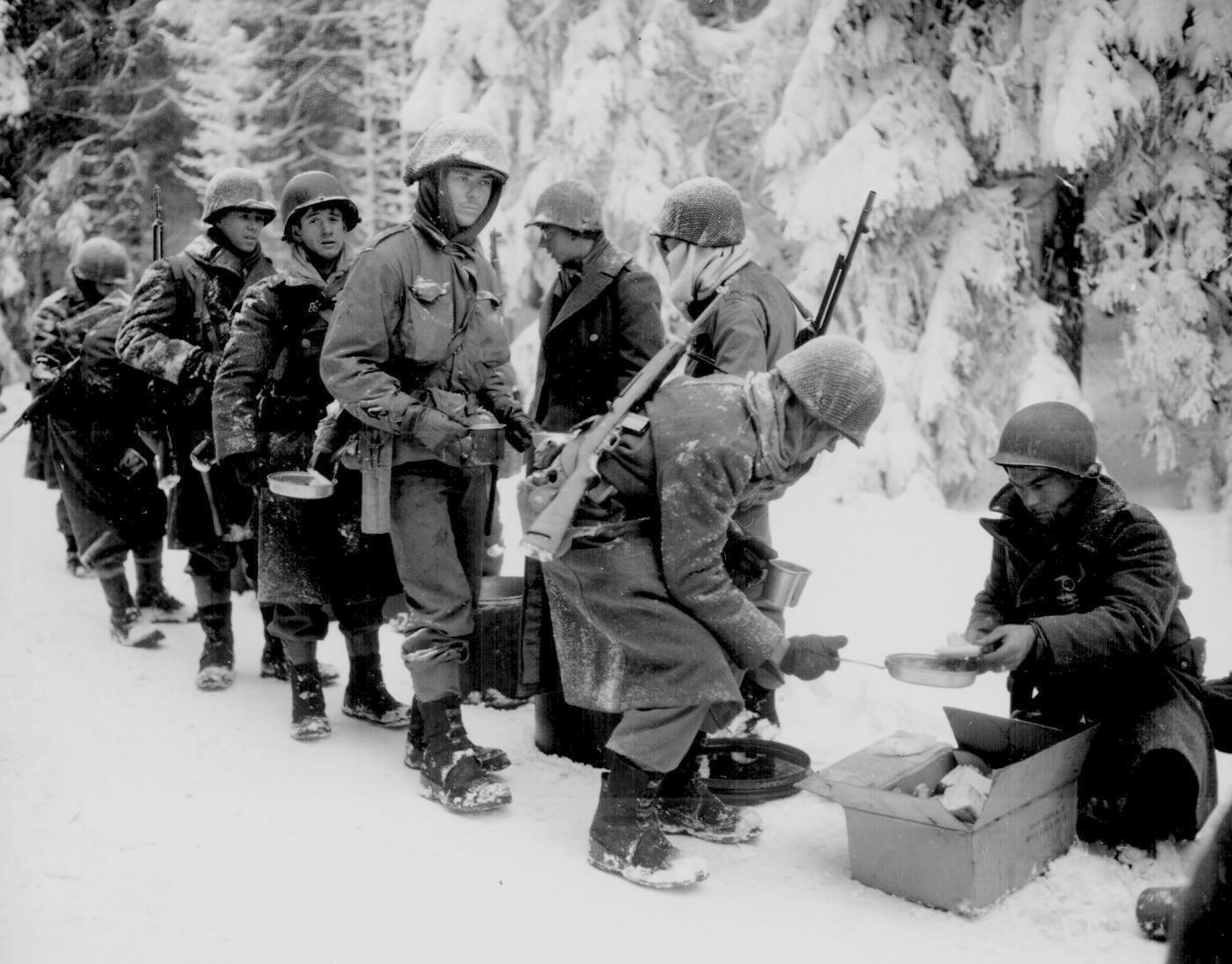
"Chow is served to American Infantrymen
on their way to La Roche, Belgium. 347th Infantry Regiment." Newhouse,
January 13, 1945.
National Archives
111-SC-198849.
But as they advance they find themselves up against a powerful German weapon ... the V1 bomb
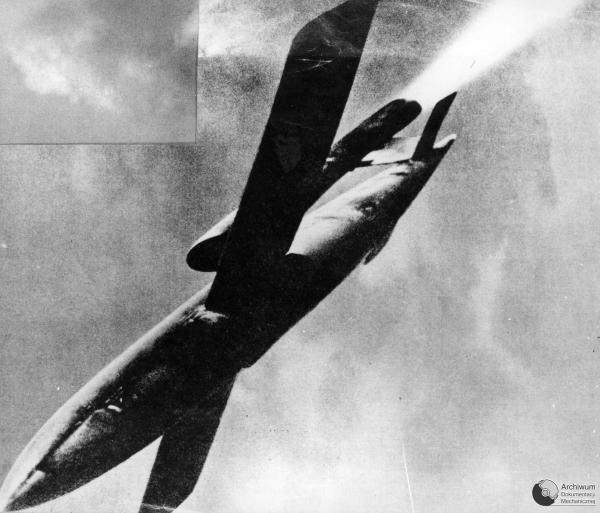
On the Eastern Front the
Soviets are pushing deep into German and East European territory
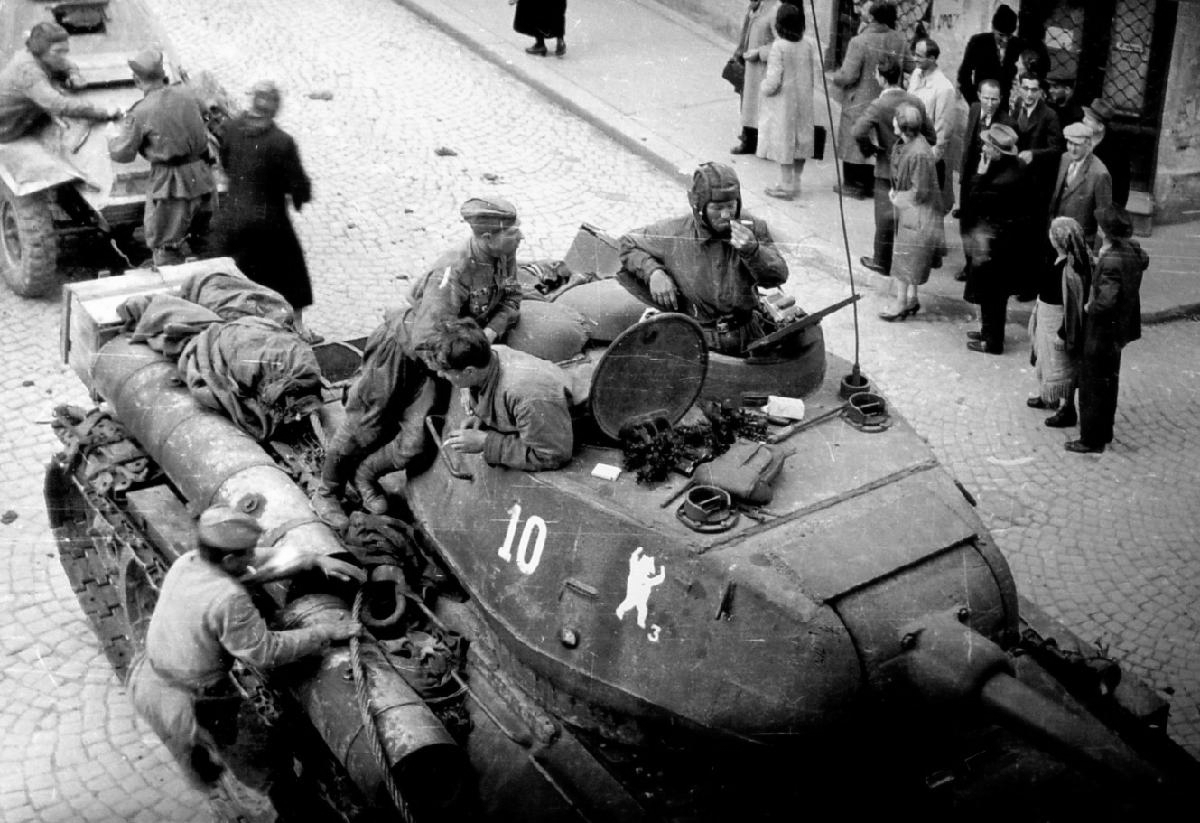
A Soviet T-34 tank on the street of
Belgrade
Political
necessity had quite naturally formed the tight alliance that existed
among the Allied leaders Roosevelt, Stalin and Churchill. But
Roosevelt’s deep idealism was another important factor in the
dynamic. Roosevelt, like all well-educated (Groton Prep
School and Harvard College) and socially quite comfortable (part of the
Rooseveltian aristocracy of New York) Humanists, saw life as directed
by basic rules of civilization that all good people follow by simple
instinct. This sense of inevitable order was what, in fact, lay
beneath the New Deal program that Roosevelt was certain would bring
America out of the Great Depression (in fact it did not. It took
putting the World War Two American war industry on its feet that did
the trick).
The publicly very polite Stalin, indeed, played quite beautifully into
this idealized picture held by Roosevelt ... who thought that he had
charmed Stalin into a very close personal relationship. In fact,
the cynicism that Churchill chose not to hide (it was clear that
Churchill did not trust Stalin) annoyed Roosevelt greatly.
Indeed, Churchill’s constant reference to the British "Empire" also
annoyed Roosevelt greatly. Americans, including their President,
were by their own political perspective supposed to be highly opposed
to the idea of "empire."
Thus it was that Roosevelt believed that he shared a certain natural
understanding with Stalin as to how a post-war world should come into
being. Indeed, he often met privately with only Stalin to talk
about the more serious issues facing the American and Soviet
superpowers ... Britain – like France – now being viewed as
secondary-level powers.
THE UNITED NATIONS ORGANIZATION |
Another
piece arising out of Roosevelt's world of Idealism was the new United
Nations Organization that Roosevelt had planned as key to the building
of a post-war world. In
most ways his proposed organization resembled the now-defunct League of
Nations ... with a General Assembly offered as a political forum for
all of the organization's member countries – and a special Security
Council to take on the trickier political issues facing the
world. And the latter component, like the League Council, would
be led by a small group of key powers, "Permanent Members" who would
always have a seat on the Security Council (but joined on the Council
by ten rotating members). And by Roosevelt’s own design, those
Permanent Members would be America and Soviet Russia ... but also Great
Britain, France and China.
These "Big Five" in fact would hold supremely important veto powers
over proposed Security Council actions. This veto power was
awarded to them to make sure that a rising political issue would not
break the relationship between these key powers and the new United
Nations Organization ... the way such matters had led to the
resignation of the great powers from the League in the 1930s.
But Roosevelt personally believed that, in any case, it would be the
natural diplomatic alliance between America and Soviet Russia that
would actually direct the post-war world. In this he would prove
correct ... in that it would be America and Soviet Russia that would
direct that world – but not as the allies he thought they would be.
BRETTON WOODS (JULY 1944) |
In
July of 1944, delegates from the 44 "United Nations" Allies gathered at
Bretton Woods, New Hampshire, for a three-week conference to put
together plans to rebuild a war-torn world. The focus was
economics, especially ways of freeing international trade and the
exchange of currencies. And thus the International Monetary Fund (IMF)
and the International Bank for Reconstruction and Development (IBRD)
were born. And the foundation of this international world would
be the American dollar. All exchange rates would be set in
relation to the dollar ... rates that could not be changed except by
agreement with the IMF.
And that would be a big problem for Stalin ... who stepped back from
this development because he saw how this played into the hands of
American capitalism. Stalin would have none of that. Thus
the first glitch in Roosevelt’s Soviet-American post-war dream world
took place. There would soon be more such glitches ... many more.
|
July 1-22, 1944 - The Bretton Woods Conference on post-war economic cooperation
... birthing the International Monetary Fund (IMF)
and International Bank for Reconstruction and Development (IBRD)
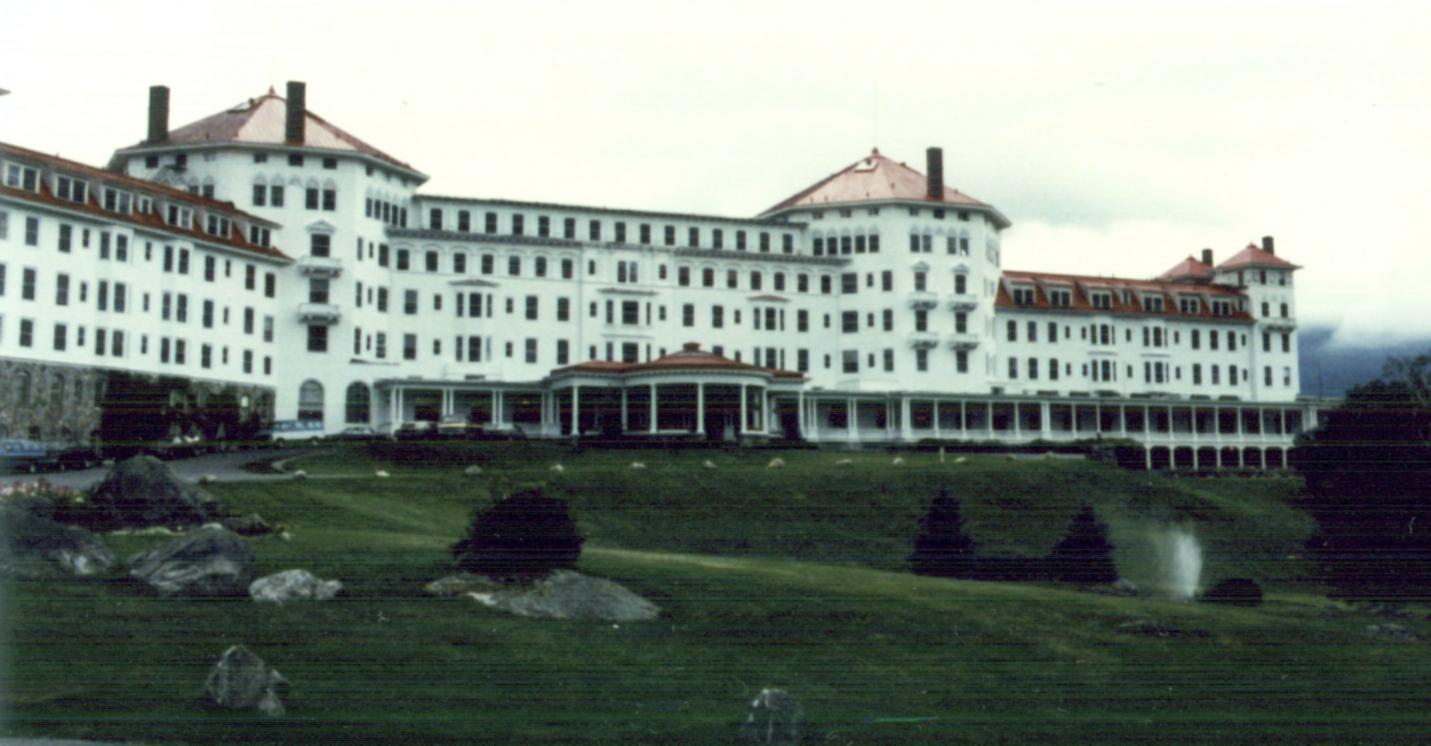
The Mount Washington Hotel at Bretton Woods where the conferences were held
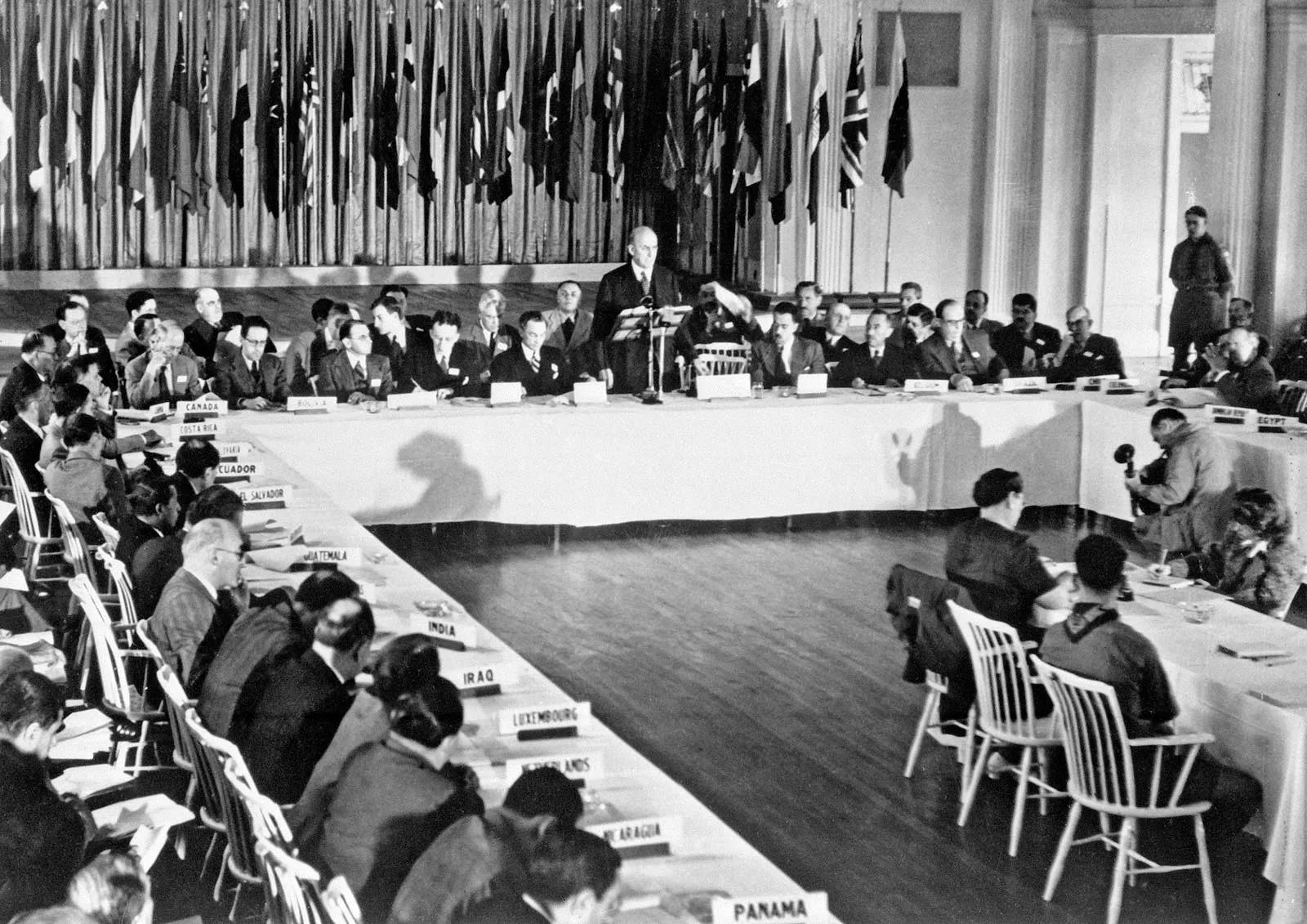
The Conference at Bretton Woods
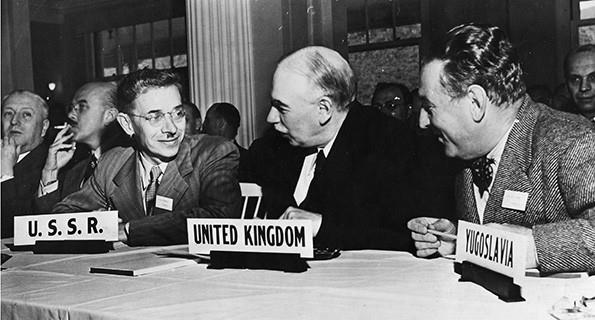
British representative Lord John Maynard Keynes visiting with the Soviet representative
By
the beginning of 1945 it was quite clear that the Nazi Reich was not
going to last much longer. With the collapse of the Reich, much of
Europe would find itself without government. Considering the
great extent of the destruction of Europe caused by the war it was
expected that immense social and political dislocation would result,
threatening the peace that the Allies were striving for.
Roosevelt, Stalin and Churchill understood that an administrative plan
of sorts would have to be laid out to provide some kind of transition
to a stable post-war Europe.
But while it looked like the war in Europe was about to come to an end,
this was hardly the case in Asia. The way the Japanese were
fighting to the last man (and often women) it appeared that the war in
Asia might drag on for many more months, even years. Thus it was
hoped by Roosevelt that Stalin might bring Russia into the Asian war
(up to that point Russia had not been at war with Japan). But as
Stalin saw no particular advantage for Russia in joining in, both
Roosevelt and Stalin knew that they would have to offer Russia some
incentives for doing so.
In February of 1945, Roosevelt, Stalin and Churchill met at the Black
Sea resort of Yalta to go over the problems of how to oversee the
rebuilding of a post-war Europe. But also on the agenda was this
matter of the war in Asia.
With respect to Europe, they basically agreed that areas under the
control of one or other of their armies (primarily American, British
and Soviet) would remain under that control or governance during a time
of "temporary" occupation. Thus most of Eastern Europe would come
under Soviet governance. Italy would come under American
governance. And Germany would be divided among Russia, America
and Britain (with France soon added by giving it portions of the
British and American zones) on the basis of their actual military
occupation at war's end. As for the most strategic part of
Germany, its capital city of Berlin, although the city fell entirely
within the Russian zone of occupation, they agreed to divide the city
itself into three (then four) zones of occupation. All of this
however was supposed to be of a temporary nature ... that is, until
Europe’s societies could get themselves up and running again.
As for the matter of enticing Stalin to bring Russia into the war
against Japan, an agreement was struck that as a result of Russian
involvement in the Asian war, Russia would be given post-war
administrative rights in the northern half of Japanese-occupied Korea
(America administering the southern half) ... and also in the entire
region of Manchuria. Indeed, Stalin promised that within two or
three months of Germany’s defeat, Russia would come into the
anti-Japanese action in Asia. The hope now was that the war there
would be over much sooner than the brutal two-year period (or more)
that they were fearing it would take to bring Japan to full defeat.
|
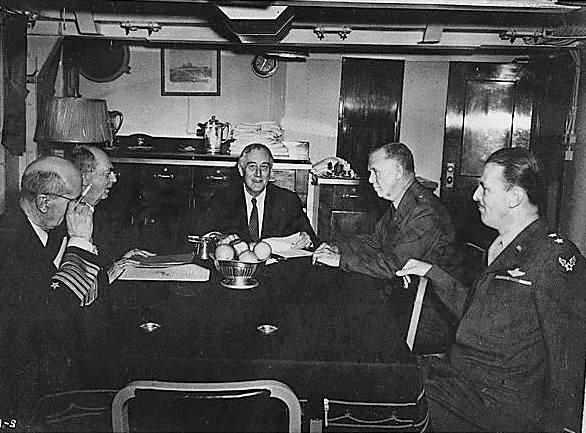
President Roosevelt with
military advisors at a Malta Conference prior to his meeting with Churchill
and Stalin at Yalta (February 1, 1945): Admiral Ernest J. King,
Admiral William Leahy, General George C. Marshall, Major General L.S. Kuter
The Allied conference at
Yalta (in the Crimea in Southern Russia/Ukraine) - February 1945. The goal: to set the
terms for the pacification of Europe
and to get Russia to actively
support the war against Japan in the East
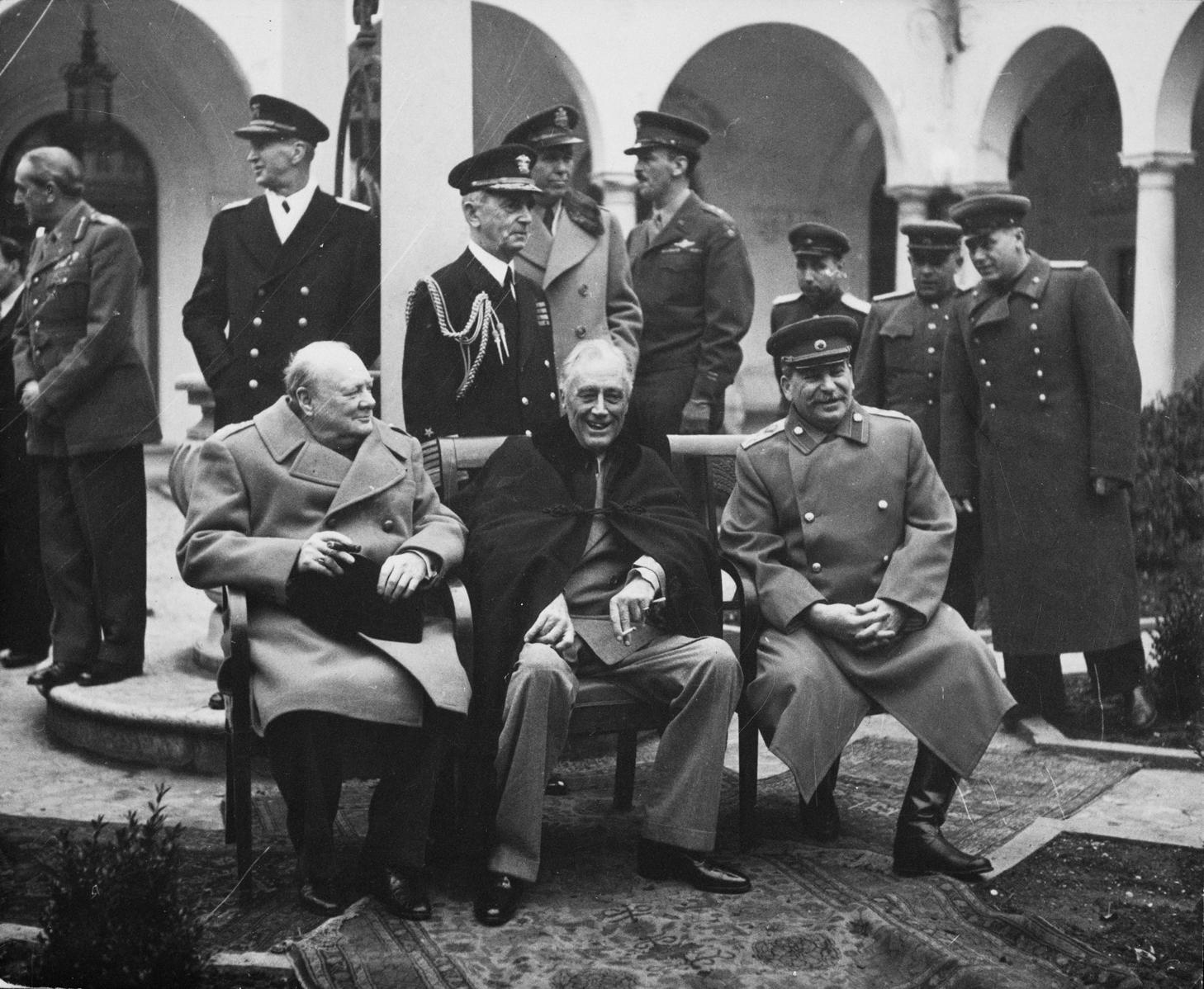
"Conference of the Big Three at Yalta
makes final plans for the defeat of Germany. Prime Minister Winston S. Churchill,
President Franklin D. Roosevelt, and Premier Josef Stalin." February 1945.
National Archives
111-SC-260486
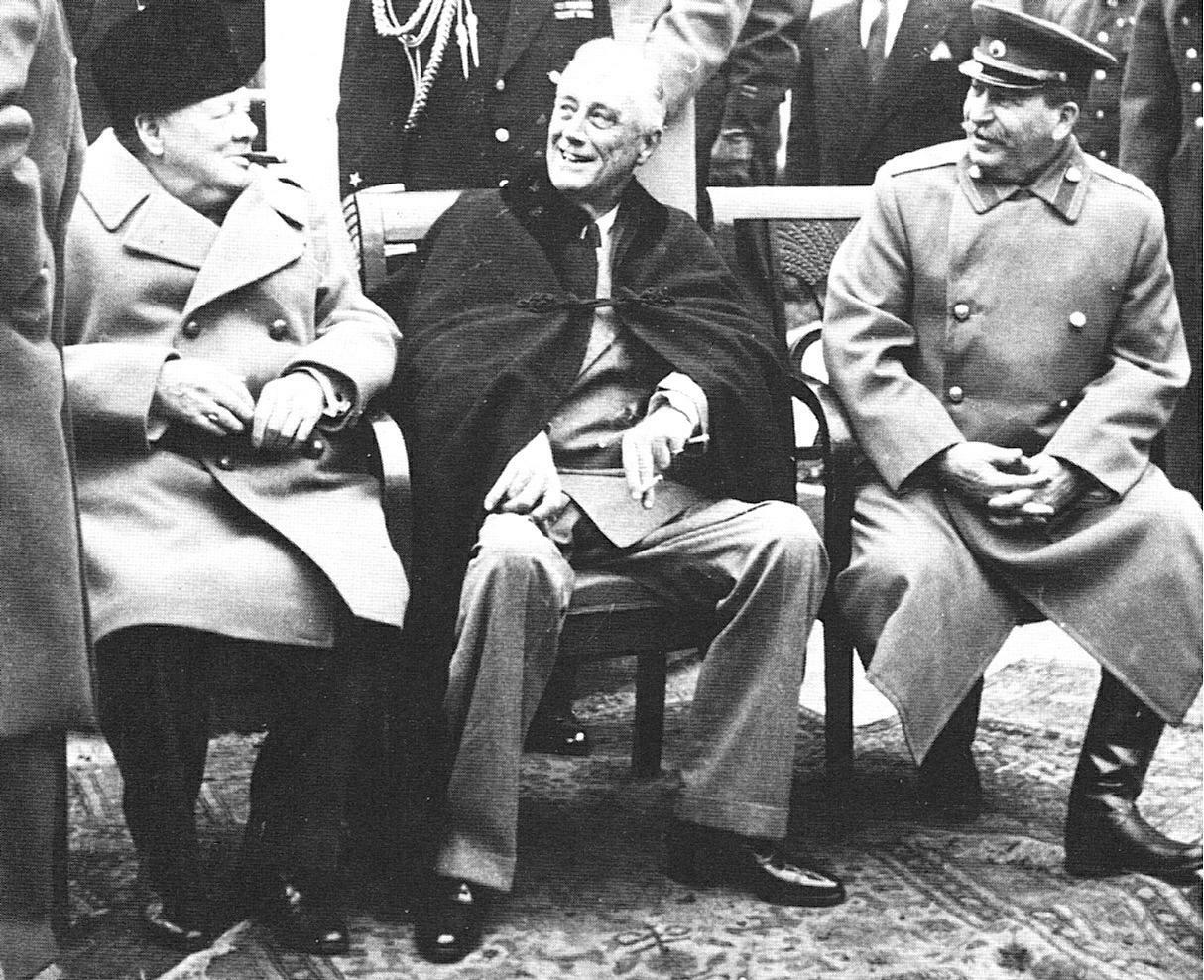
Winston Churchill, Franklin
Roosevelt, and Joseph Stalin at Yalta - February 1945
Franklin D. Roosevelt
Library
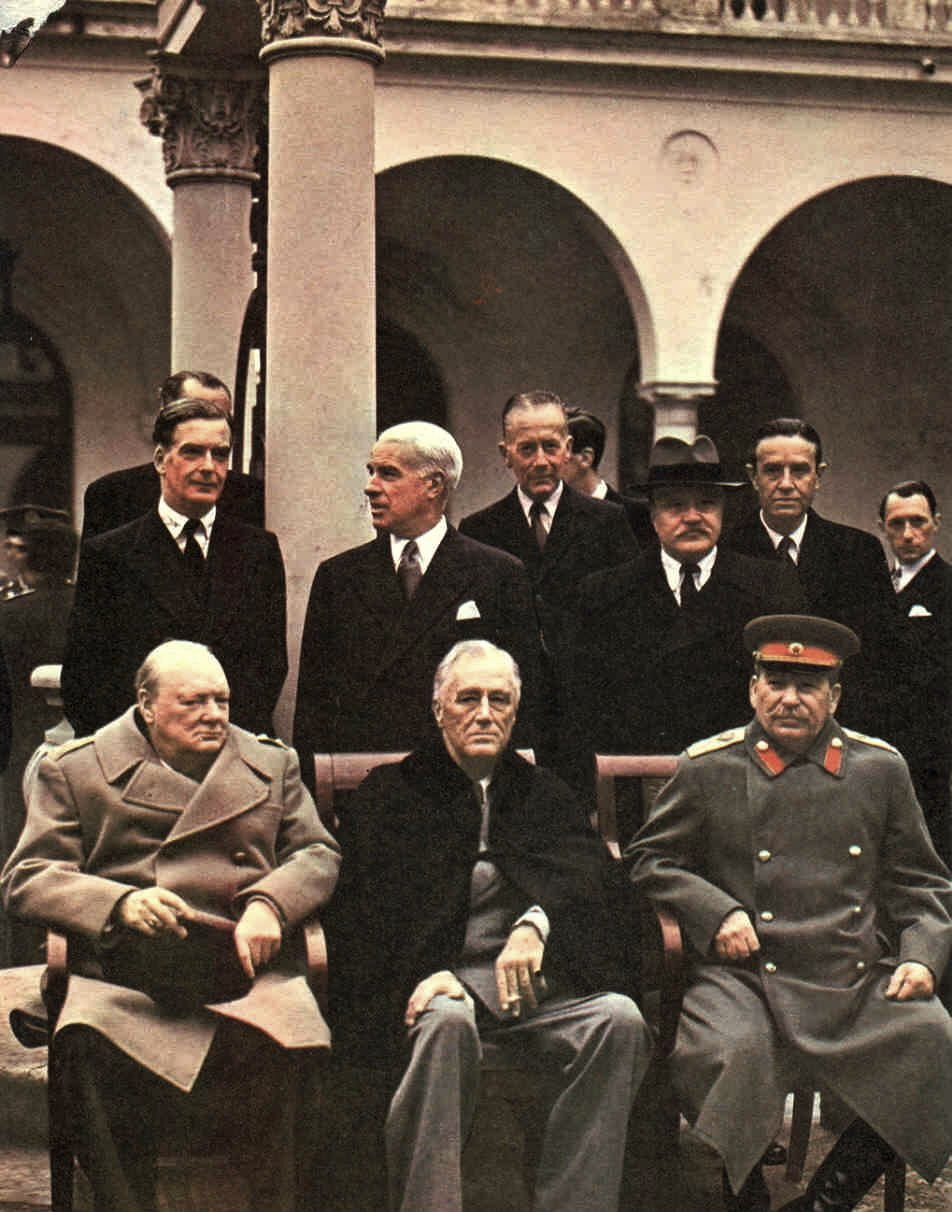
Churchill, Roosevelt and
Stalin at Yalta - February 1945 (behind them: Sir
Anthony Eden, Edward R. Stettinius, Jr., Sir Alexander Cadogan, Vyacheslav
Molotov and Averell Harriman). Note: Roosevelt is
not in good health; the trip to Yalta greatly drained his strength.
Franklin D. Roosevelt
Library
THE
GERMANS IN FULL RETREAT ACROSS GERMANY |
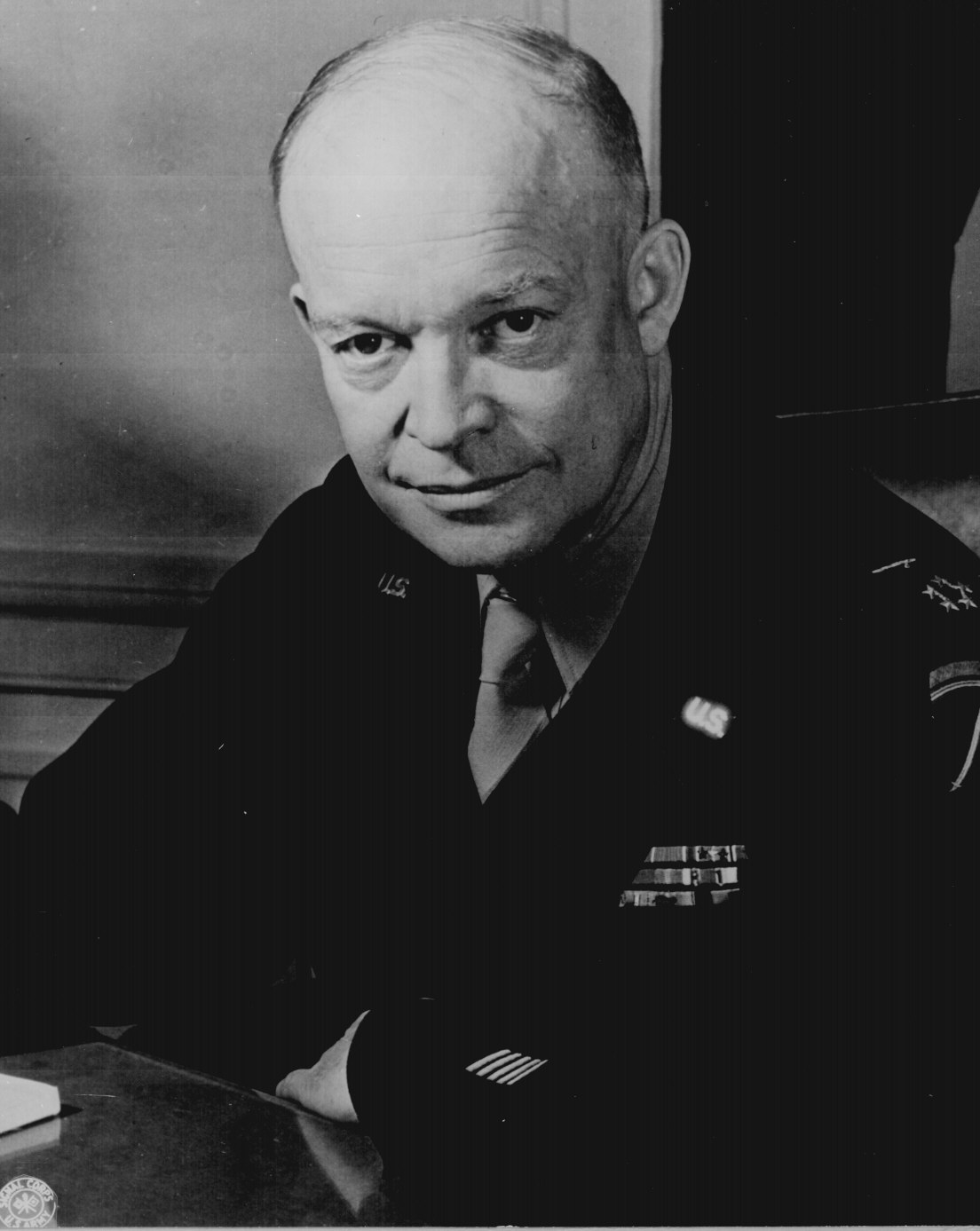
"General Dwight D. Eisenhower,
Supreme Allied Commander, at his headquarters in the European
theater of operations. He wears the five-star cluster of the
newly-created rank of General of the Army." T4c. Messerlin, February 1, 1945.
National Archives
80-G-331330
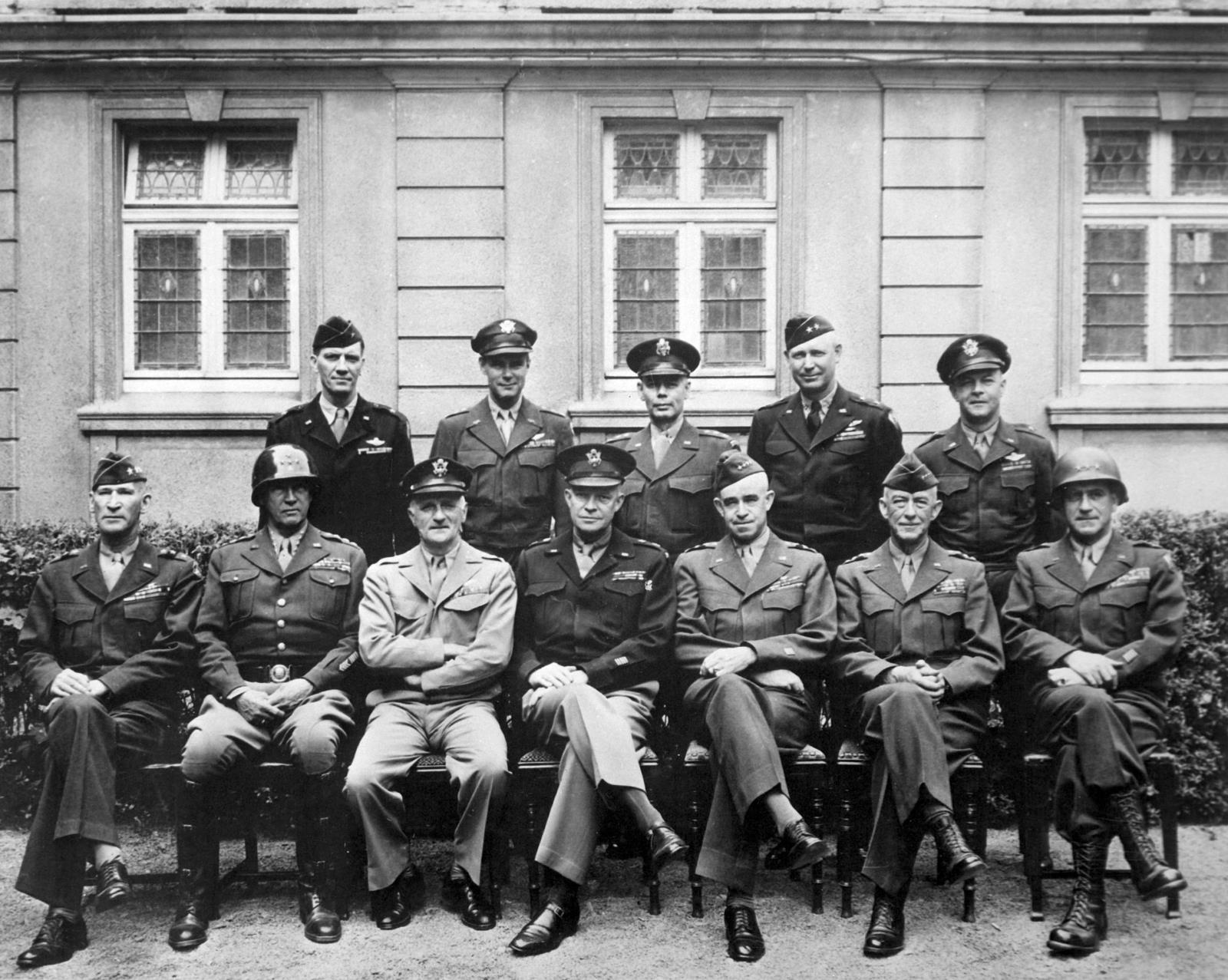
American generals: seated left
to right are William H. Simpson, George S. Patton,
Jr., Carl Spaatz,
Dwight D. Eisenhower, Omar Bradley, Courtney H. Hodges, and
Leonard T. Gerow; standing are Ralph F. Stearley, Hoyt
S. Vandenberg, Walter Bedell Smith, Otto P. Weyland, and Richard E. Nugent.
ca. 1945.
National Archives
208-YE-182.
At this Point the Allies Are Streaming
into Germany

"Then came the big day when we marched
into Germany – right through the Siegfried Line." 1945
National Archives
208-YE-193
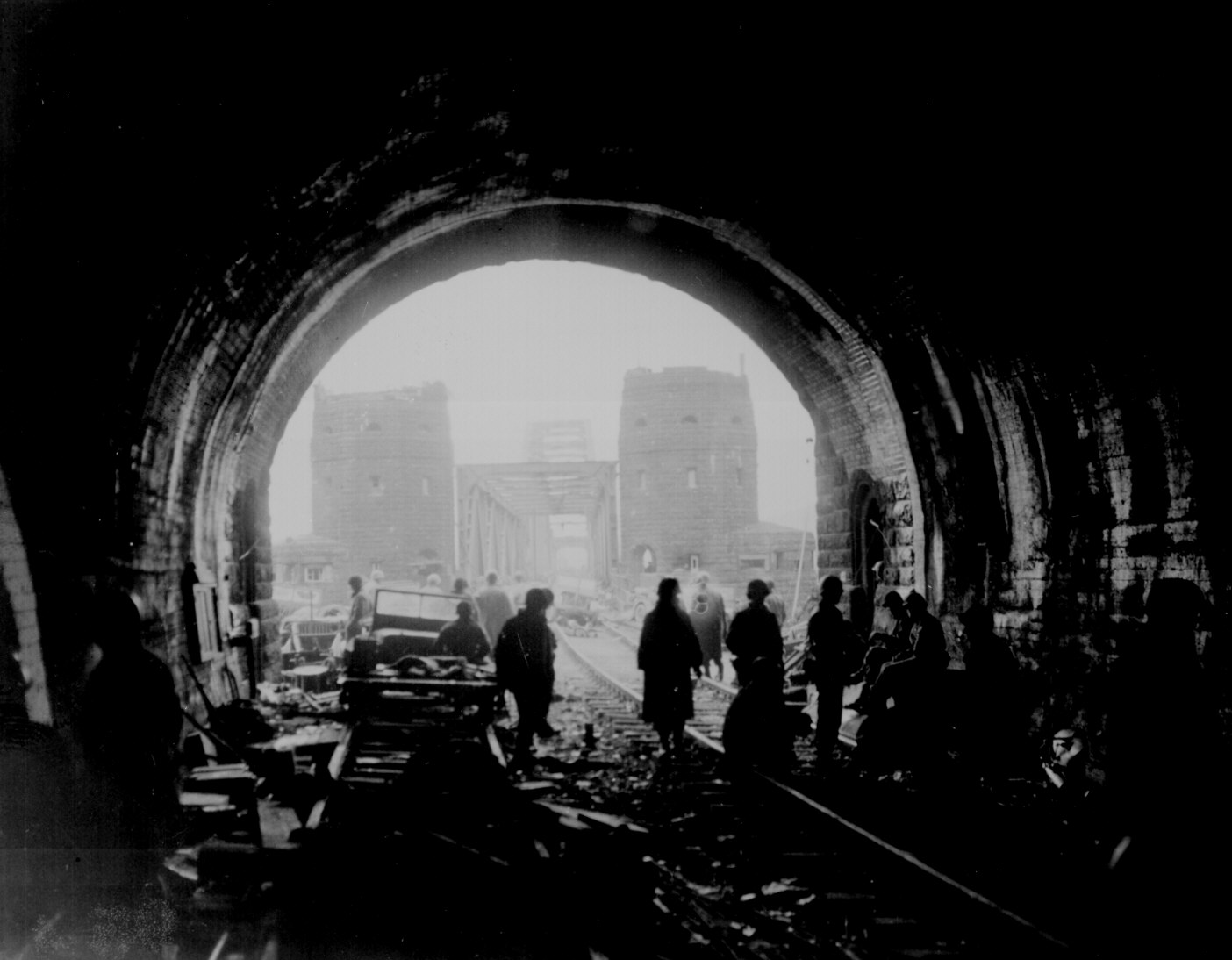
"First U.S. Army men and equipment pour
across the Remagen Bridge; two knocked out jeeps in foreground."
Sgt. William Spangle, Germany, March 11, 1945.
National Archives
111-SC-201973.
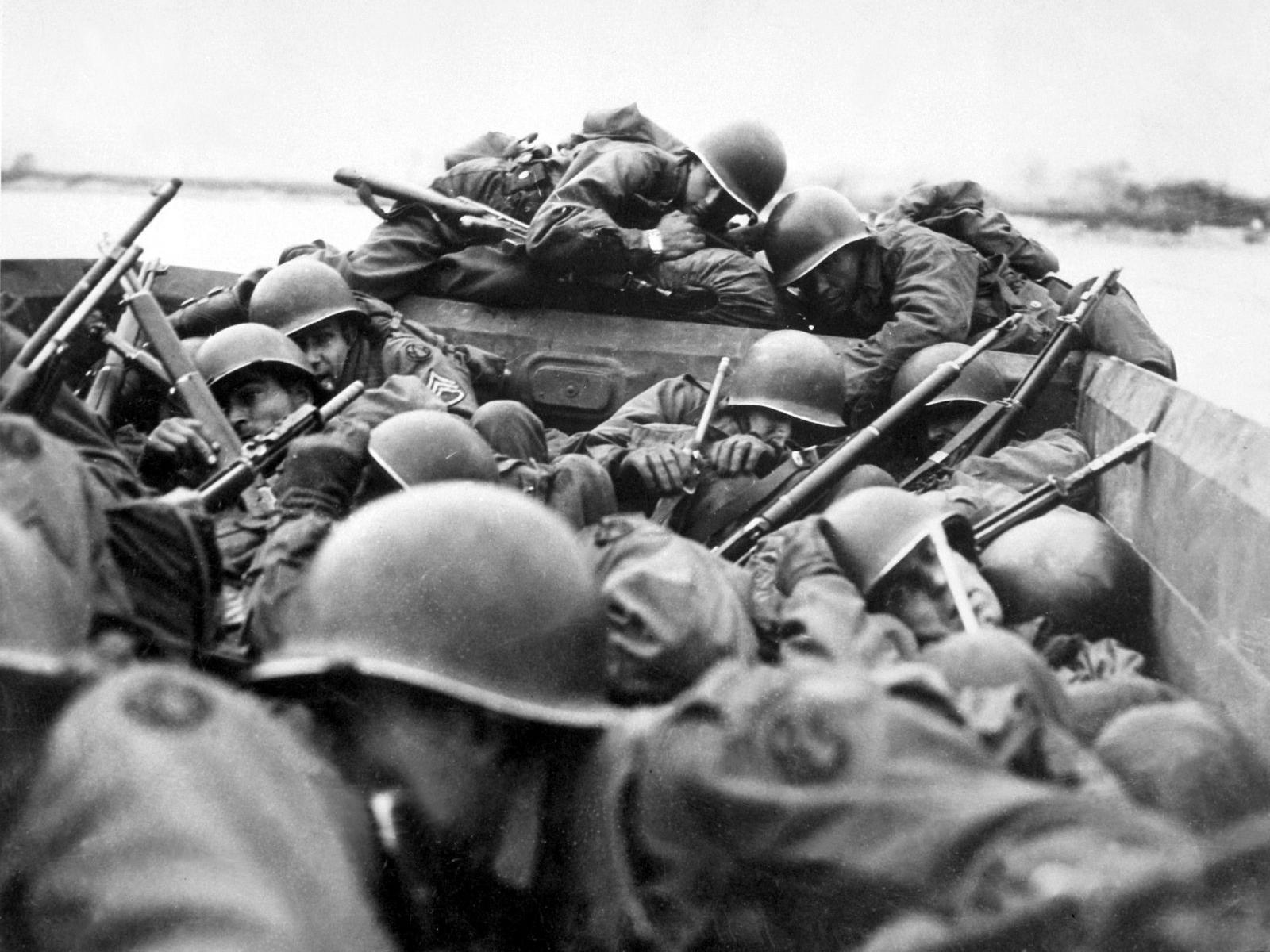
"I drew an assault boat to cross
in – just my luck. We all tried to crawl under each other
because the lead was flying around like hail." Crossing the Rhine under enemy fire
at St. Goar. March 1945.
National Archives
208-YE-132
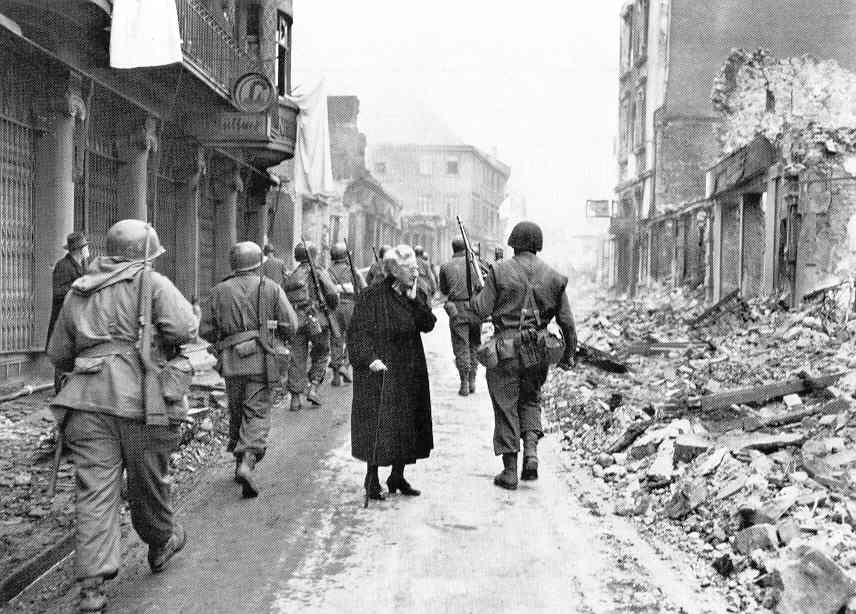
American infantry moving
through Bensheim, Germany as a woman contemplates the destruction
– March
1945
National Archives
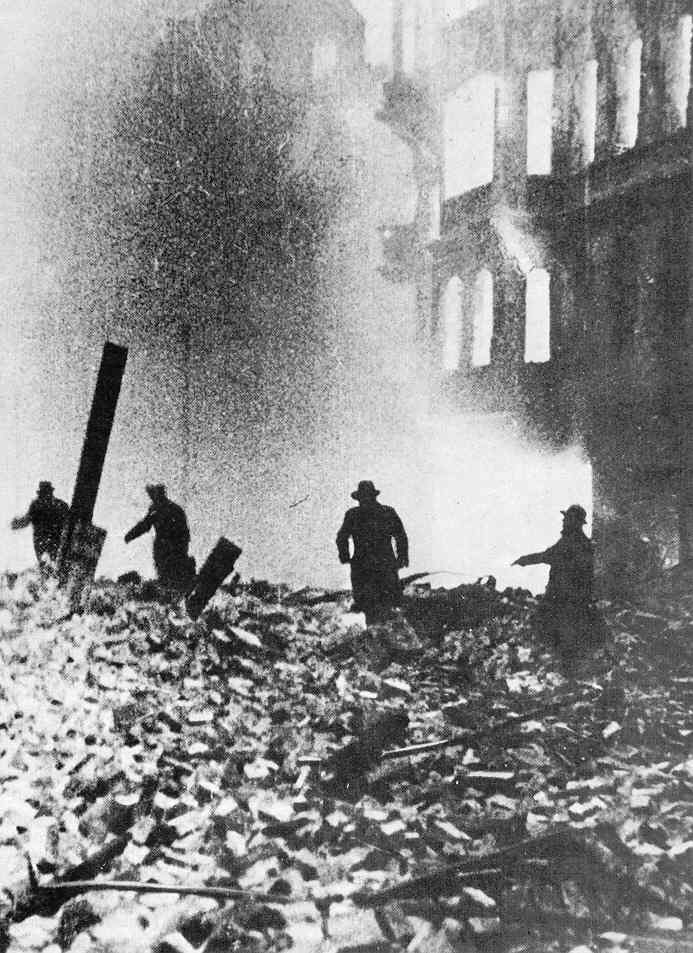 Berliners in a burning Berlin – 1945
Berliners in a burning Berlin – 1945
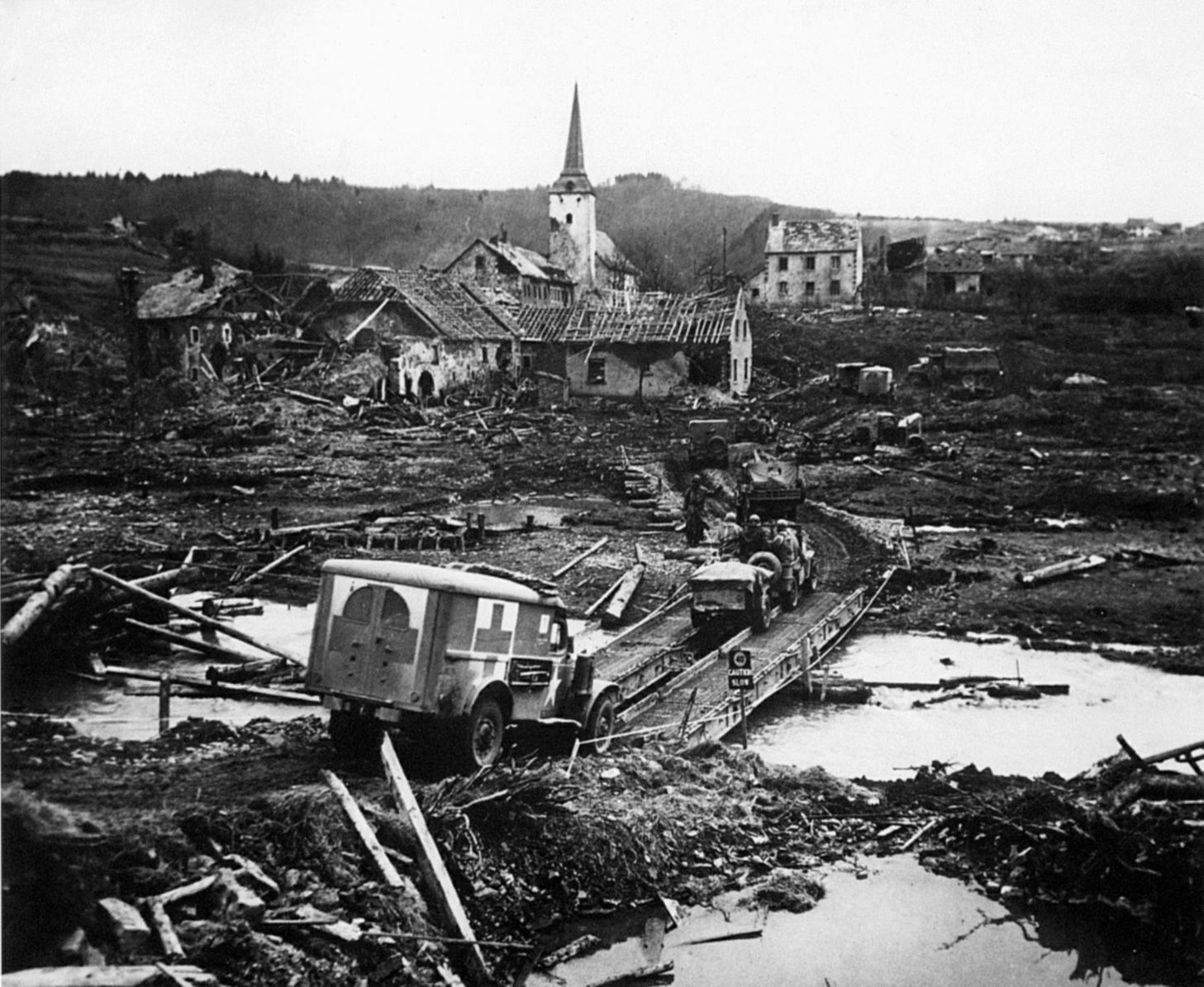
"All this inanimate wreckage
around us was little enough compensation for the human wreckage
we
hauled back and forth, back and forth. Lunebach, Germany" – ca.
March 1945
National Archives
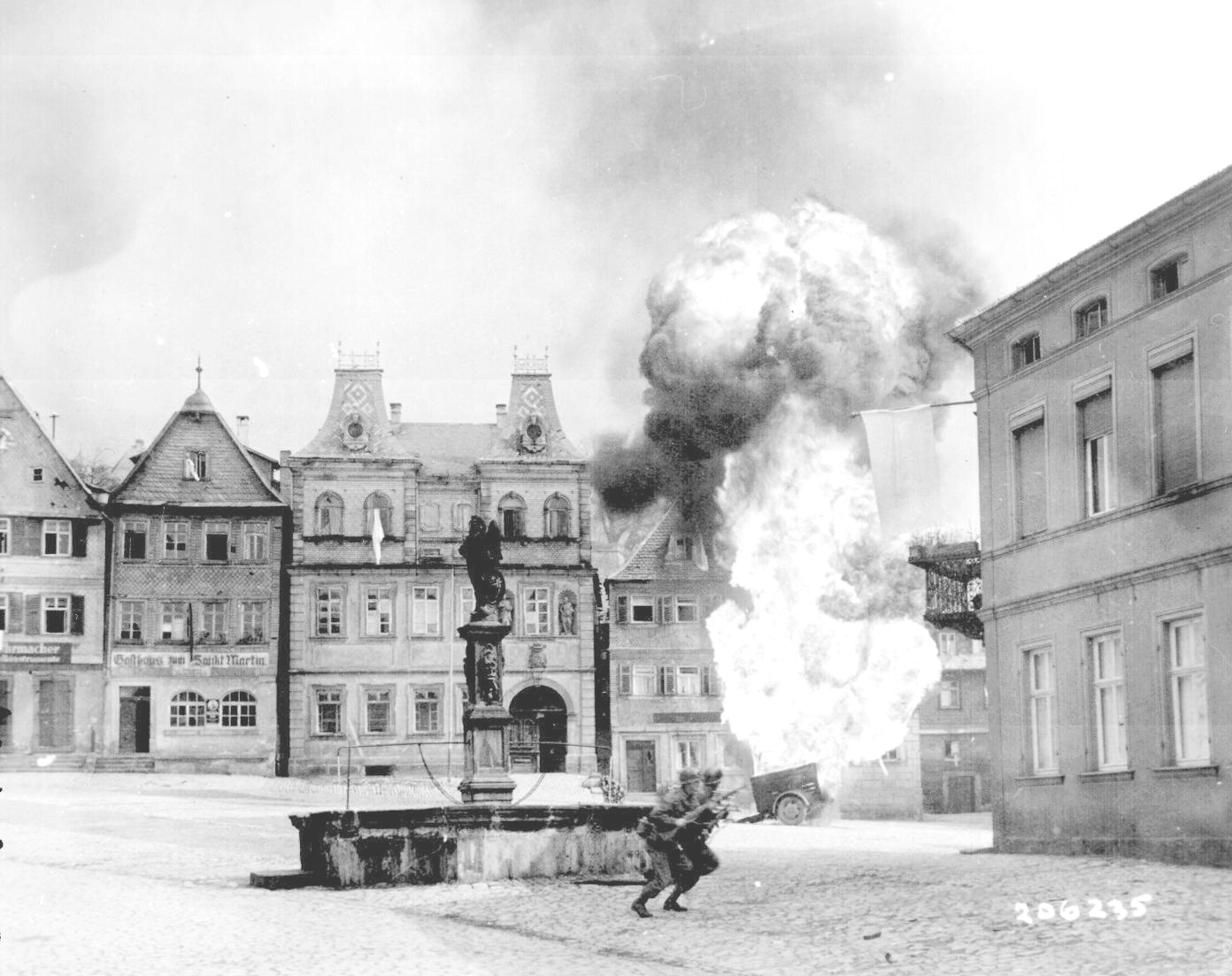
"Two anti-tank Infantrymen of the 101st
Infantry Regiment, dash past a blazing German gasoline
trailer in square of
Kronach, Germany."
T4c. W. J. Rothenberger, April 14,
1945.
National Archives
111-SC-206235.
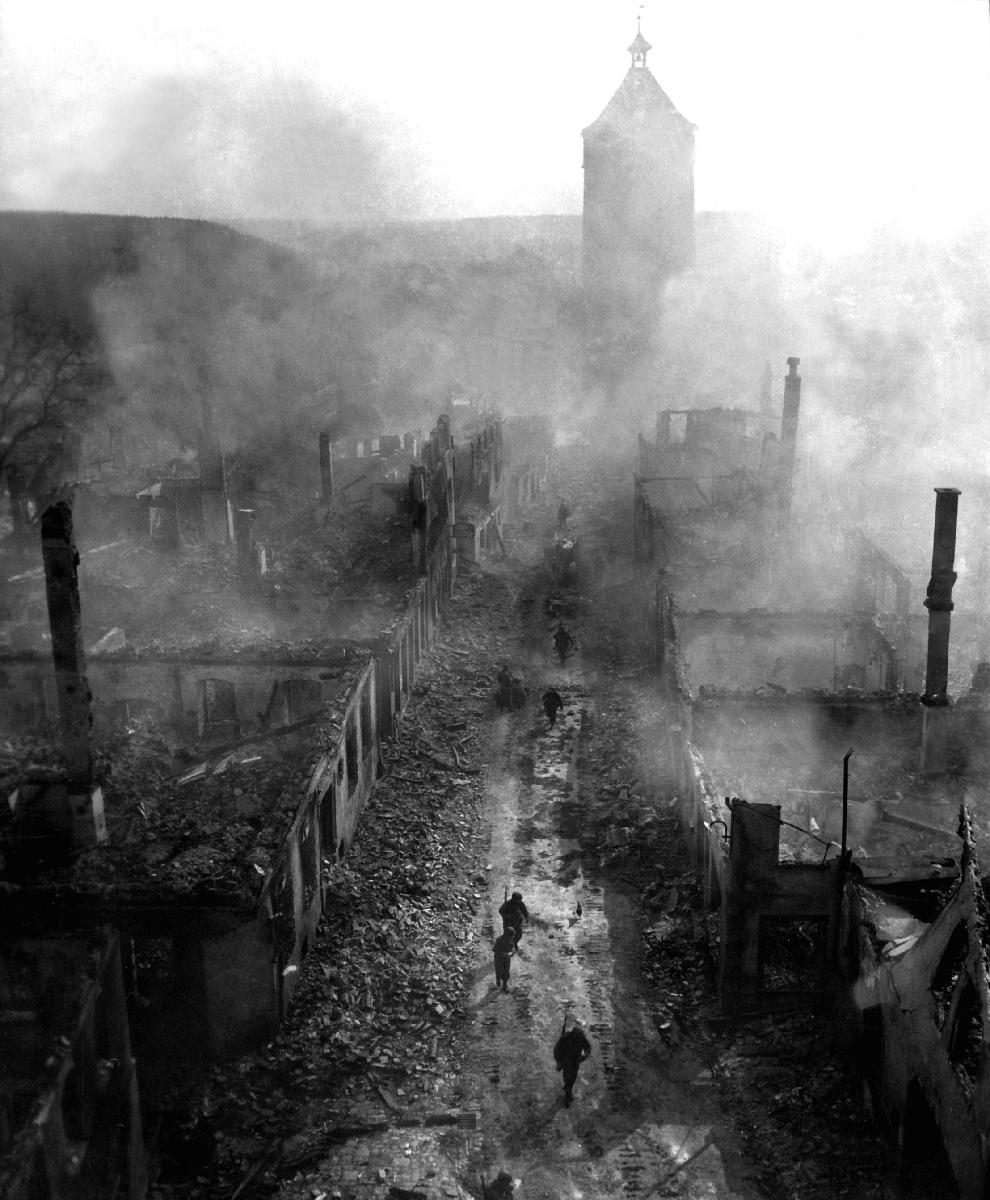
"Infantrymen of the 255th Infantry Regiment
move down a street in Waldenburg to hunt the Hun after a recent raid
by 63rd Division." 2d Lt. Jacob Harris, April 16, 1945.
National Archives
111-SC-205778
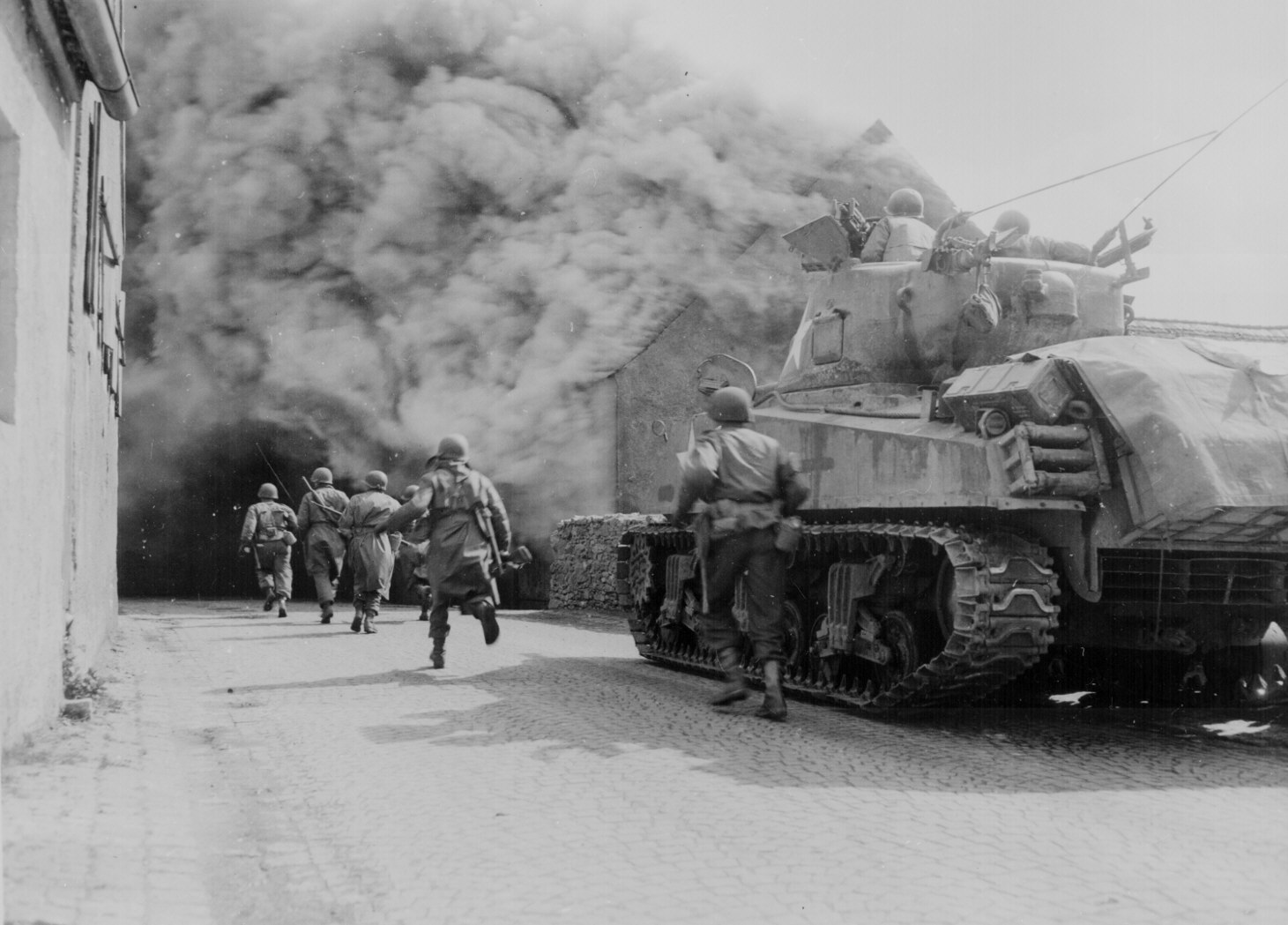
"Soldiers of the 55th Armored Infantry
Battalion and tank of the 22nd Tank Battalion, move through smoke filled street. Wernberg,
Germany." Pvt. Joseph Scrippens, April 22, 1945.
National Archives
111-SC-205298.
But the Germans continue to give full account of themselves in the North (Holland) and the South (Italy)

Canadian Infantry of the Regiment de
Maisonneuve, moving through Holten to Rijssen, Netherlands. Lt. D. Guravitch,
April 9, 1945.
National Archives
306-NT-1334B-11.

"Moving up through Prato, Italy,
men of the 370th Infantry Regiment have yet to climb the mountain which lies
ahead." Bull, April 9, 1945.
National Archives
111-SC-205289.
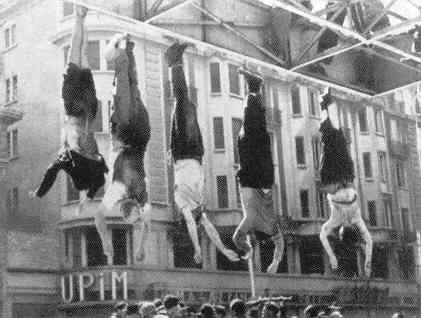 The corpses of Mussolini,
his mistress Clara Petacci and other Fascists
strung up in Milan by the Italians themselves - May
1945
The corpses of Mussolini,
his mistress Clara Petacci and other Fascists
strung up in Milan by the Italians themselves - May
1945
U.S. Army Air Forces
 Miles
H. Hodges Miles
H. Hodges
| | |


 The offensive against the Germans
The offensive against the Germans The United Nations Organization
The United Nations Organization
 The Germans in full retreat across
The Germans in full retreat across


























 The corpses of Mussolini,
his mistress Clara Petacci and other Fascists
strung up in Milan by the Italians themselves - May
1945
The corpses of Mussolini,
his mistress Clara Petacci and other Fascists
strung up in Milan by the Italians themselves - May
1945
